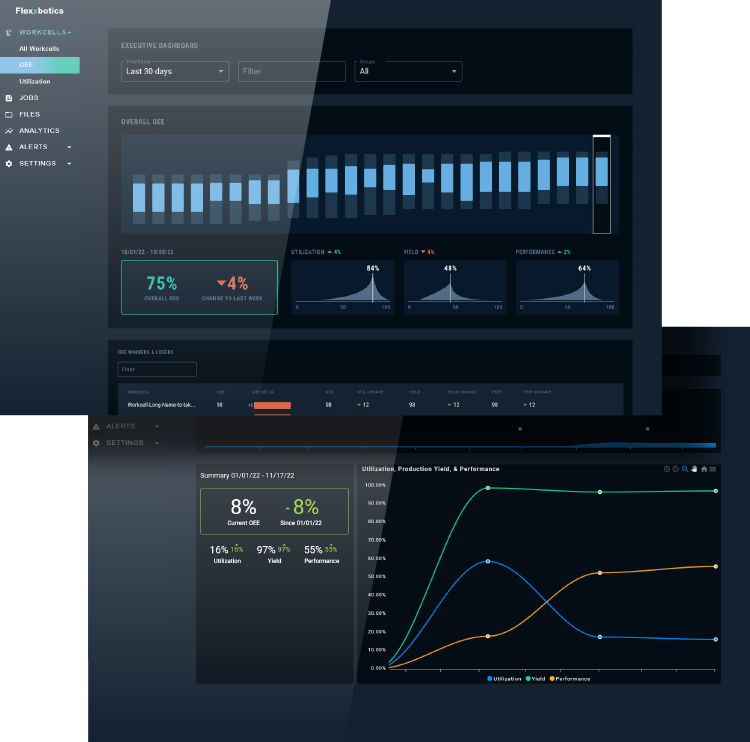
By Flexxbotics: 12/5/2022
The Right Way To Get Real-Time
Manufacturing Data
Data analytics is a vital tool for today’s leading manufacturers. The insights they gain allow them to operate smarter, more productive, and more efficient operations. However, not all manufacturers currently take advantage of the opportunity data provides in their facilities. Understanding what data analytics for manufacturing is and how to leverage this opportunity enables manufacturers to optimize their operations better than ever before.
What is Manufacturing Analytics?
Manufacturing data analytics is collecting and analyzing data from machines and operations to make better business decisions. Such data can include machine performance data, inventory models over time, QA measurements, and downtime reports. By analyzing this data, companies can arrive at insights that help them diagnose problems, improve machine performance, and run a more profitable business. Companies collect data for manufacturing analytics via manual and automated methods. Likewise, they can perform data analysis through manual or software-assisted means. However, the amount of data provided by manufacturing machinery today means that companies can lose out on many insights by relying on manual methods alone.
Why is Manufacturing Data Important?
The amount of potential data from a manufacturing line and its potential impact can be invaluable for modern manufacturers. In the short-term, companies that leverage data analytics find it easier to make improvements and identify problems in their processes. Companies can better support their customers and interface more intelligently with suppliers by enriching their ERP and MES systems with manufacturing data.
Manufacturing Data Helps Define Effectiveness
Defining machine performance and effectiveness without data is a challenge. Without data, manufacturers are blind to how their machines are performing and where potential problem spots might be. Overall Equipment Effectiveness (OEE) is a gold standard for measuring optimal machines’ performance, but it requires data inputs to be calculated. And while other KPIs are more effective for measuring robot effectiveness, those measurements will also require data.
Manufacturing data also allows operators to measure the real-time performance of their equipment. Facilities use real-time data capture to display visualizations on HMI screens or SCADA systems. These tools allow operators and management to understand how their equipment performs in real time. By leading with data first, manufacturers can react quickly to alarms and correct potential problems.
Data Illuminates Areas of Improvement
Over time, manufacturing data can identify problem spots in your manufacturing process. Manufacturers use stored data to look for patterns indicative of issues. Perhaps during a certain time of day, a machine’s performance drops slightly, or part quality falls off. These problems might go unnoticed without the aid of data analysis to illuminate these insights.
Device history and logging allow operations managers to review machine performance before and after changes have been made to the system. Manufacturers can be hesitant to change their machines if they can’t verify that the changes have positively impacted them. However, device history and logging data allow companies to move forward with confidence on changes to the system because they know they can see the results and decide if the changes are worthwhile.
Types of Manufacturing Data Collection Systems

Manual:
Manufacturers generally collect data in two ways: manual and automated methods. Even manufacturers with little experience or ability to leverage data analytics perform some level of manual data collection. They can gather at least some level of data through simple observation. Data points such as approximate cycle time, estimated throughput, and quality assurance metrics can be estimated over short periods of time. However, it’s often inefficient to dedicate staff to data collection over the long term. This is crucial because long-term data offers the most actionable insights for manufacturers.

Automated:
Automated data collection systems are much more scalable. Thanks to the emergence of industry 4.0, the number of devices that support manufacturing data collection is increasing each year significantly. These systems also offer a higher level of data resolution than manual observation. Automated systems can measure thousands of data points per second. This is valuable information for manufacturers looking for every competitive edge they can find in their facility. Machines’ control systems can be a gold mine of potential performance data. However, extracting this data is only the first step–making sense of the data is critical.
Creating Data Pipelines
Usable data unlocks the possibility of using a fully integrated manufacturing tech stack. Data from the machine level is accessible to operators via an HMI. This data feed comes from sensors and the control system of the machine. Additionally, more detailed data is available at the SCADA level for multiple machines. This allows for supervisory control over an entire plant floor for plant managers. Machine-level monitoring provides real-time performance statistics to analyze effectiveness, performance, and efficiency. Machine data is fed to the MES system for performance analysis, data acquisition, and operational control. Management can monitor MES and ERP systems that–with the enriched data from the shop floor–can now make better decisions around scheduling, labor, and resource allocation.

While manufacturing data is immensely valuable, it means little without the right context. Extracting the data is the easy part, relatively speaking. For most companies, that involves ingesting data into a data lake for storage. However, this data is unprocessed and disorganized in such a state. Contextualization is getting this data in a state that’s usable for stakeholders. Contextualizing data might include:
– Data cleaning and normalization
– Data aggregation
– Data transformation
– Defining data schemas
– Creating relationships between data sets

Of course, all this contextualized data should be stored in a relational database. Manufacturers can analyze historical data to look for trends and opportunities to improve their operations continuously. Powerful data visualization tools allow stakeholders to communicate findings from the data trends to support their conclusions.
Without contextualized data, decision-makers and analysts can’t ask questions about the data that will deliver those valuable insights to the business. It’s not data itself, but data that is usable that is of value to business leaders. Once data is properly contextualized, decision-makers can analyze it for insights.
Measuring Performance
with the FlexxConnect UR™
Integrating a manufacturing analytics stack from scratch can be a daunting task. However, it’s critical to running an efficient and optimized manufacturing operation. It’s especially important when running automated robotic workcells due to the dynamic nature of the application. The FlexxConnect UR™ lowers the barrier to entry for manufacturers looking to automate with a data-forward model in mind. The FlexxConnect UR™ offers three major benefits to manufacturers automating machines such as CNCs, injection molding machines, or inspection stations.


Ease of Use
The FlexxConnect UR™ is easy for operators with little to no robotics experience. Non-programmers configure jobs through a no-code interface. This empowers machine operators to assume ownership of the work cell. Now that manufacturers can quickly set up new jobs, your cobot spends more time in operation and less downtime for programming.

Real-Time Data
Quick access to status and performance data is critical for understanding the status of your machine. The real-time data provided by the FlexxConnect UR™ shows operators the current status of the workcell. Operators can quickly react to changes or issues with this immediate access to performance data. Many manufacturers feel that they don’t have the personnel to extract and contextualize data for proper machine analytics–the FlexxConnect UR™ provides pre-built analytics tools, giving manufacturers actionable insights they can use to improve critical metrics such as throughput, cycle time, or production efficiency.

Cell Performance Analytics
Access to performance data is key for decision-makers. The FlexxConnect UR™ provides manufacturing data collection software for key stakeholders to analyze cell performance. Manufacturers can calculate OEE and other KPIs to optimize their UR. Management can leverage historical performance data to look for trends and areas of opportunity.

BONUS: Flexxbotics Integration Service
As a value-added service, Flexxbotics will fully integrate your Flexxbotics hardware and software into your workcell. This removes a massive lift for manufacturers new to robotic automation, manufacturing data analytics, or both. Flexxbotics can even remotely integrate the FlexxConnect UR™ into your existing business systems. This way, you can focus on running a productive automated workcell operation while leveraging all the benefits that manufacturing data has to offer.
Interested in learning more? You can read more about
the FlexConnect UR™ here or reach out to us today!
